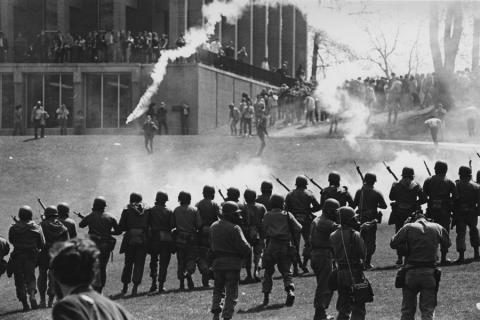This photo depicts a scene near Kent State's Taylor Hall after the National Guards had fired tear gas at the students. Note that the Guardsmen have their rifle bayonets in a fixed position. Image 1425 from the Kent State University archive of the May 4, 1970 shooting. Online, courtesy Kent State University. Click on the image for a better view.
While parents engaged in anti-busing protests, college campuses seethed with anti-war sentiments. "Peace with honor" (as Richard Nixon liked to say) seemed an elusive concept.
As the President conducted a press conference on April 30, 1970 (to explain why he had sent B-52s into Cambodia to bomb "Viet Cong" strongholds), a protest at Kent State University was brewing. It began the next day (May 1, 1970). Among other reasons, students were upset that innocent Cambodians were being killed.
By May 4th, members of the Ohio National Guard, sent to the Kent State campus, were ready for battle. Armed with tear gas, rifles and fixed bayonets, they looked as though they were about to end an armed insurrection.
Examining the evidence photographs today, one can only wonder what both sides must have been thinking when the National Guard fired (don't miss this video) into the crowd of students milling about on campus.

This map, which is part of the President's Commission on Campus Unrest report, depicts a drawing of the Kent State University campus at the time of the shootings on May 4, 1970. The illustration shows where each of the four students were located when they were fatally shot by the National Guardsmen. Map online, courtesy U.S. National Archives.
Four unarmed students were killed and nine others were injured at Kent State. (One individual, Dean Kahler, was permanently paralyzed.) Not all the dead students were part of the .
After the shootings, an injunction temporarily closed the University. Students (scroll down to "Photos") and their professors had to find other means to finish the term.
Meanwhile, as African-American students were still trying to find other means to begin equal educational opportunities, the case filed by Dr. Swann had made its way to the United States Supreme Court.


 Back
Back
 Next Chapter
Next Chapter

 Back
Back
 Next Chapter
Next Chapter

